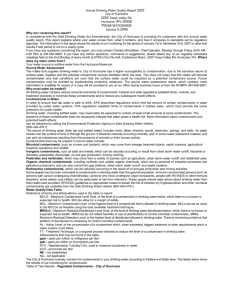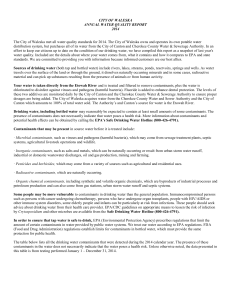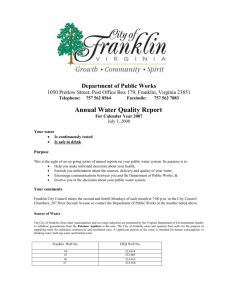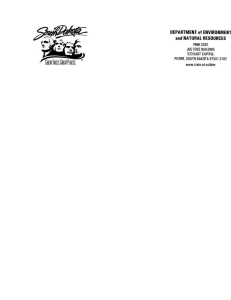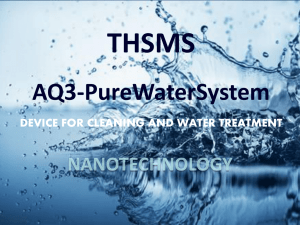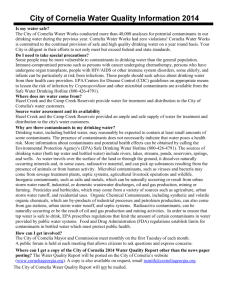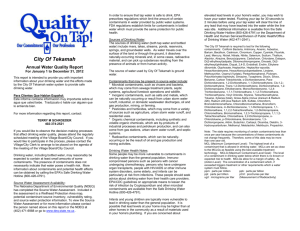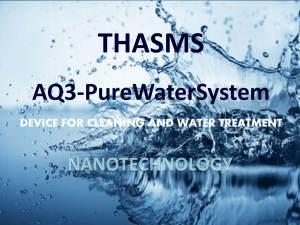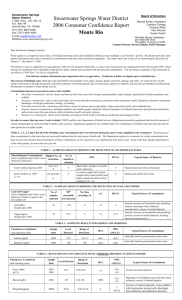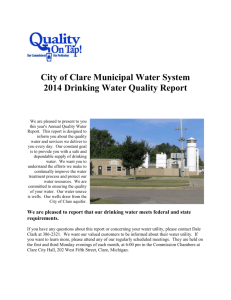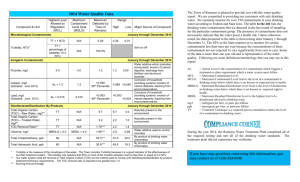Annual Drinking Water Quality Report 2006
advertisement
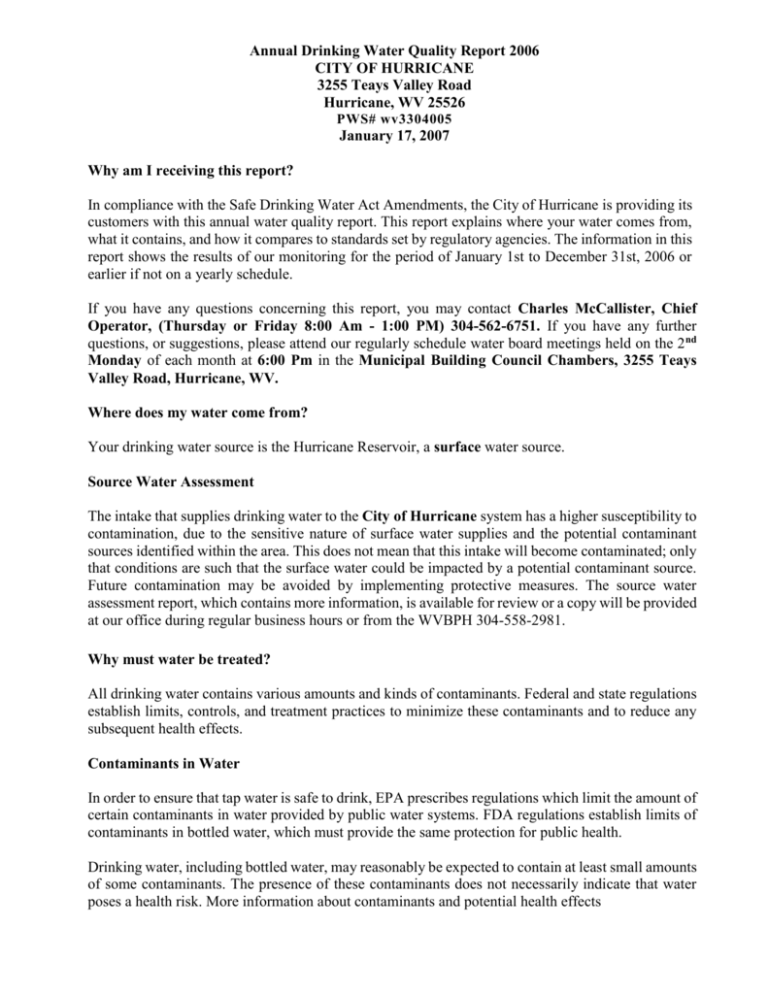
Annual Drinking Water Quality Report 2006 CITY OF HURRICANE 3255 Teays Valley Road Hurricane, WV 25526 PWS# wv3304005 January 17, 2007 Why am I receiving this report? In compliance with the Safe Drinking Water Act Amendments, the City of Hurricane is providing its customers with this annual water quality report. This report explains where your water comes from, what it contains, and how it compares to standards set by regulatory agencies. The information in this report shows the results of our monitoring for the period of January 1st to December 31st, 2006 or earlier if not on a yearly schedule. If you have any questions concerning this report, you may contact Charles McCallister, Chief Operator, (Thursday or Friday 8:00 Am - 1:00 PM) 304-562-6751. If you have any further questions, or suggestions, please attend our regularly schedule water board meetings held on the 2 nd Monday of each month at 6:00 Pm in the Municipal Building Council Chambers, 3255 Teays Valley Road, Hurricane, WV. Where does my water come from? Your drinking water source is the Hurricane Reservoir, a surface water source. Source Water Assessment The intake that supplies drinking water to the City of Hurricane system has a higher susceptibility to contamination, due to the sensitive nature of surface water supplies and the potential contaminant sources identified within the area. This does not mean that this intake will become contaminated; only that conditions are such that the surface water could be impacted by a potential contaminant source. Future contamination may be avoided by implementing protective measures. The source water assessment report, which contains more information, is available for review or a copy will be provided at our office during regular business hours or from the WVBPH 304-558-2981. Why must water be treated? All drinking water contains various amounts and kinds of contaminants. Federal and state regulations establish limits, controls, and treatment practices to minimize these contaminants and to reduce any subsequent health effects. Contaminants in Water In order to ensure that tap water is safe to drink, EPA prescribes regulations which limit the amount of certain contaminants in water provided by public water systems. FDA regulations establish limits of contaminants in bottled water, which must provide the same protection for public health. Drinking water, including bottled water, may reasonably be expected to contain at least small amounts of some contaminants. The presence of these contaminants does not necessarily indicate that water poses a health risk. More information about contaminants and potential health effects can be obtained by calling the Environmental Protection Agency's Safe Drinking Water Hotline (800-426-4791). The source of drinking water (both tap and bottled water) includes rivers, lakes, streams, ponds, reservoirs, springs, and wells. As water travels over the surface of land or through the ground, it dissolves naturally occurring minerals, and, in some cases radioactive material, and can pick up substances resulting from the presence of animals or from human activity. Contaminants that may be present in source water include: Microbial contaminants, such as viruses and bacteria, which may come from sewage treatment plants, septic systems, agricultural livestock operations and wildlife. Inorganic contaminants, such as salts and metals, which can be naturally-occurring, or result from urban storm water runoff, industrial or domestic wastewater discharges, oil and gas production, mining, farming. Pesticides and herbicides, which may come from a variety of sources such as agriculture, urban storm water runoff, and residential uses. Organic chemical contaminants, including synthetic and volatile organic chemicals, which are by-products of industrial processes and petroleum production, and can, also come from gas stations, urban storm water runoff, and septic systems. Radioactive contaminants, which can be naturally occurring or the result of oil and gas production and mining activities. Some people may be more vulnerable to contaminants in drinking water than the general population. Immuno-compromised persons such as persons with cancer undergoing chemotherapy, persons who have undergone organ transplants, people with HIV/AIDS or other immune disorders, some elderly, and infants can be particularly at risk from infections. These people should seek advice about drinking water from their health care providers. EPA/CDC guidelines on appropriate means to lessen the risk of infection by Cryptosporidium and other microbial contaminants are available from the Safe Drinking Water Hotline (800-426-4791). Water Quality Data Table Definitions of terms and abbreviations used in the table or report: MCLG - Maximum Contaminant Level Goal, or the level of a contaminant in drinking water below which there is no known or expected risk to health. MCLGs allow for a margin of safety. MCL - Maximum Contaminant Level, or the highest level of a contaminant that is allowed in drinking water. MCLs are set as close to the MCLGs as feasible using the best available treatment technique. MRDLG - Maximum Residual Disinfectant Level Goal, or the level of drinking water disinfectant below which there is no known or expected risk to health. MRDLGs do not reflect benefits of use of disinfectants to control microbial contaminants. MRDL - Maximum Residual Disinfectant Level, or the highest level of disinfectant allowed in drinking water. There is convincing evidence that addition of disinfectant is necessary to control microbial contaminants/ AL - Action Level, or the concentration of a contaminant which, when exceeded, triggers treatment or other requirements which a water system must follow. TT - Treatment Technique, or a required process intended to reduce the level of a contaminant in drinking water. Abbreviations that may be found in the table: ppm - parts per million or milligrams per liter ppb - parts per billion or micrograms per liter NTU - Nephelometric Turbidity Unit, used to measure cloudiness in water NE - not established N/A - not applicable The City of Hurricane routinely monitors for contaminants in your drinking water according to federal and state laws. The tables below show the results of our monitoring for contaminants. Table of Test Results - Regulated Contaminants - City of Hurricane Contaminant Violation Y/N Level Detected MCLG MCL NTU 0 TT Soil runoff ppm NA TT Naturally present in the environment ppm 1.3 AL=l.3 Corrosion of household Unit of Measure Likely Source of Contamination Microbiological Contaminants Turbidity N .06 100% of monthly samples <0.3 Total organic carbon N 6.4 Inorganic Contaminants Copper N 0.251 plumbing, erosion of natural deposits Fluoride N 0.43 Ppm 4 4 Nitrate N 0.38 ppm 10 10 Erosion of natural deposits; Runoff from fertilizer use; Erosion from natural deposits Volatile Organic Contaminants Chlorine N Haloacetic acids 2.1 (Avg.) (Range 2.0-2.2) ppm MRDLG 49 N (Yearly ppb (HAAC5) Water additive used to control microbes 4 By-product of &inking water disinfection NA. Avg.) Total trihalomethanes (TTHMs) 60 N 37.8 By-product of drinking water chlorination NA ppb (Range 80 3 3 -4 1 ) *Copper and lead samples were collected from 20 area residences on June 21, 2006. Only the 90 percentile is reported.. None of the samples collected exceeded the MCL. Table of test Results - Unregulated Contaminants Contaminant Violation YIN Level Detected Sodium* N 15 Sulfate N 21 Unit of Measure ppm MCA MCI Likely Source of Contamination t 20 Erosion of natural deposits t 250 Erosion of natural deposits ppm WE ARE PLEASED TO REPORT THAT THE CITY OF HURRICANE MEET ALL, FEDERAL ,A..NW STATE WATER STANDARDS FOR THE REPORTING YEAR 2006. Additional Information Another water test results for the reporting year 2006 were all non-detects_ "Turbidity is a measure of the cloudiness in the water. We monitor it because it is a good indicator of the effectiveness of our filtration system". This report will not be mailed.. A copy will be provided upon request at our office during regular business hours.
